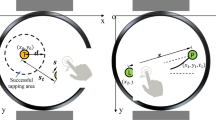Abstract
Movement retraining has proven to be a reliable way of treating compensatory movement faults, however, it is time-consuming and requires a lot of attention from a physiotherapist. Reliable movement retraining assistance system could enable patients to perform retraining exercises at home, thus increasing the possible exercise performance frequentness and consequently hasten the improvement. This paper describes a smart shirt system for movement retraining assistance. The smart shirt system is based on textile stretch sensors that are positioned over the typical movement fault sites for movement detection and monitoring. The information from the textile stretch sensors is used as visual feedback by the wearer for movement corrections. To verify the feasibility of the retraining assistance system, it was tested with a set of compensatory movement tests and retraining exercises. Each exercise was performed in a correct and incorrect manner, and the sensor measurement was analyzed to confirm the difference in measured signals between both cases. In total 11 exercises were performed to cover all of the typical compensatory movement sites, and for each retraining exercise, at least one sensor was identified, whose measurement could be used as feedback for the particular exercise.















Similar content being viewed by others
References
Comerford M, Mottram SL. Movement and stability dysfunction – contemporary developments. Man Ther. 2001;6(1):15–26.
Sahrmann S, Azevedo DC, Dillen LV. Diagnosis and treatment of movement system impairment syndromes. Braz J Phys Ther. 2017;21(6):391–9. https://doi.org/10.1016/j.bjpt.2017.08.001.
Mottram S, Warner M, Chappell P, Morrissey D, Stokes M. Impaired control of scapular rotation during a clinical dissociation test in people with a history of shoulder pain. 3rd International Conference on Movement Dysfunction. 30 Oct - 01 Nov 2009. (2009).
van Dillen LR, Maluf KS, Sahrmann SA. Further examination of modifying patient preferred movement and alignment strategies in patients with low back pain during symptomatic tests. Man Ther. 2009;14(1):52–60.
Dankaerts W, O’Sullivan P, Burnett A, Straker L, Davey P, Gupta R. Discriminating healthy controls and two clinical subgroups of nonspecific chronic low back pain patients using trunk muscle activation and lumbosacral kinematics of postures and movements: a statistical classification model. Spine. 2009;34(15):1610–8.
Jull GA, Falla D, Vicenzino B, Hodges PW. The effect of therapeutic exercise on activation of the deep cervical flexor muscles in people with chronic neck pain. Man Ther. 2009;14(6):696–701.
Roussel NA, Daenen L, Vissers D, Lambeets D, Schutt A, Van Moorsel A, et al.: Motor control and physical fitness training to prevent musculoskeletal injuries in professional dancers. In: 3rd International Conference on Movement Dysfunction, 30 October–1 November, Edinburgh, UK (2009).
Comerford M, Mottram S. Kinetic control: the management of uncontrolled movement. Amsterdam: Elsevier; 2012.
Maceira-Elvira P, Popa T, Schmid A, Hummel FC. Wearable technology in stroke rehabilitation: towards improved diagnosis and treatment of upper-limb motor impairment. J NeuroEngineering Rehabil. 2019;16:142. https://doi.org/10.1186/s12984-019-0612-y.
Muhammad Sayem AS, Hon Teay S, Shahariar H, Luise Fink P, Albarbar A. Review on smart electro-clothing systems (SeCSs). Sensors. 2020;20(3):587. https://doi.org/10.3390/s20030587.
Giorgino T, Tormene P, Lorussi F, De Rossi D, Quaglini S. Sensor evaluation for wearable strain gauges in neurological rehabilitation. IEEE Trans Neural Syst Rehabil Eng. 2009;17(4):409–15. https://doi.org/10.1109/tnsre.2009.2019584.
Lorussi F, Carbonaro N, De Rossi D, Paradiso R, Veltink P, Tognetti A. Wearable textile platform for assessing stroke patient treatment in daily life conditions. Front Bioeng Biotech. 2016;4. https://doi.org/10.3389/fbioe.2016.00028.
McLaren R, Joseph F, Baguley C, Taylor D. A review of e-textiles in neurological rehabilitation: how close are we? J NeuroEng Rehabil. 2016;13(1). https://doi.org/10.1186/s12984-016-0167-0.
Eizentals P, Katashev A, Oks A, Semjonova G. Smart shirt for uncontrolled movement retraining. J. Henriques et al, editors. MEDICON 2019, IFMBE Proc 76. p. 933–937, 2020. https://doi.org/10.1007/978-3-030-31635-8_113.
Oks A, Katashev A, Litvak J (2015). Knitted resistive fabric: properties and applications. Materials Science Textile and Clothing Technology. 2015; 9(28). https://doi.org/10.7250/mstct.2014.005.
Tognetti A, Bartalesi R, Lorussi F, De Rossi D. Body segment position reconstruction and posture classification by smart textiles. Trans Inst Meas Control. 2007;29(3–4):215–53. https://doi.org/10.1177/0142331207069487.
Esfahani MIM, Nussbaum MA. A “smart” undershirt for tracking upper body motions: task classification and angle estimation. IEEE Sensors J. 2018:1–1. https://doi.org/10.1109/jsen.2018.2859626.
Mattmann C, Amft O, Harms H, Troster G, Clemens F. Recognizing upper body postures using textile strain sensors. 2007 11th IEEE International Symposium on Wearable Computers. 2007. https://doi.org/10.1109/iswc.2007.4373773.
Mokhlespour Esfahani M, Zobeiri O, Moshiri B, Narimani R, Mehravar M, Rashedi E, et al. Trunk motion system (TMS) using printed body worn sensor (BWS) via data fusion approach. Sensors. 2017;17(12):112. https://doi.org/10.3390/s17010112.
Luomajoki H, Kool J, de Bruin ED, Airaksinen O. Improvement in low back movement control, decreased pain and disability, resulting from specific exercise intervention. BMC Sports Science, Medicine and Rehabilitation. 2010; 2(1). https://doi.org/10.1186/1758-2555-2-11.
Grimaldi A, Richardson C, Durbridge G, Donnelly W, Darnell R, Hides J. The association between degenerative hip joint pathology and size of the gluteus maximus and tensor fascia lata muscles. Man Ther. 2009;14(6):611–7.
Funding
This work has been supported by the European Regional Development Fund within the Activity 1.1.1.2 “Post-doctoral Research Aid” of the Specific Aid Objective 1.1.1 “To increase the research and innovative capacity of scientific institutions of Latvia and the ability to attract external financing, investing in human resources and infrastructure” of the Operational Program “Growth and Employment” (No. 1.1.1.2/VIAA/1/16/153).
Author information
Authors and Affiliations
Corresponding author
Ethics declarations
Conflict of interest
The authors declare that they have no conflict of interest.
Additional information
Publisher’s note
Springer Nature remains neutral with regard to jurisdictional claims in published maps and institutional affiliations.
Rights and permissions
About this article
Cite this article
Eizentals, P., Katashev, A., Oks, A. et al. Smart shirt system for compensatory movement retraining assistance: feasibility study. Health Technol. 10, 861–874 (2020). https://doi.org/10.1007/s12553-020-00420-x
Received:
Accepted:
Published:
Issue Date:
DOI: https://doi.org/10.1007/s12553-020-00420-x




